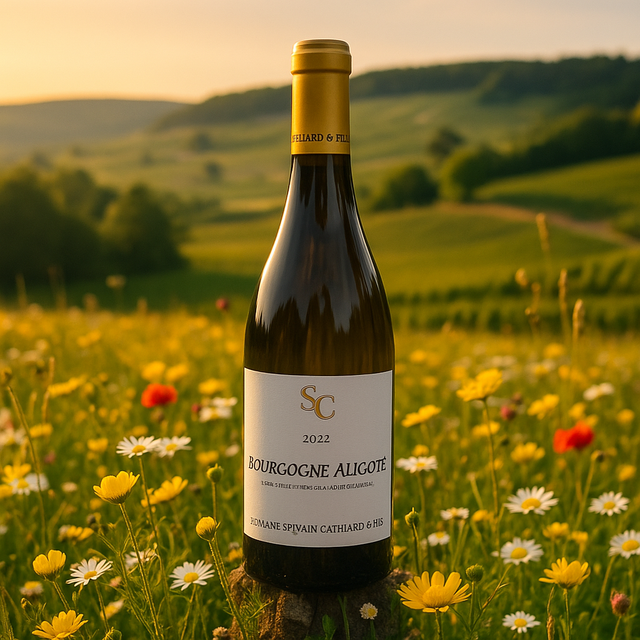Burgundy Club: June 2025
Today is June the 1st and it's getting hot, so time for poolside sippers! But not these three wines - they deserve a full feast with proper stemware. This month's release features no Chardonnay, but instead an Aligote from one of the best overall producers in the region. The reds are two classics both built to age.
White Wine (both club levels): Sylvain Cathiard Bourgogne Aligote 2022
Sylvain Cathiard is a Vosne-Romanée based producer mostly known for producing some of the best reds from that village which rival those of heavy hitters such as Domaine de la Romanee Conti (DRC) and Domaine Leroy. They are super spendy and super rare. In fact, if I walked into some celebrity cellar and they had a lineup of Cathiard instead of DRC I'd be even more impressed as this domaine is much more of an insider's jewel than it is famous around the world.
Now, onto the white. Aligote has a centuries long history in Burgundy, but it ripens about 10 days later than Chardonnay, much to its own detriment. Chardonnay became the favored white to replant post phylloxera and is now synonymous with white Burgundy. Still, a handful of highly respected Aligotes exist and I suspect it will regain reputation as it is more suited for the warmer climate of the 21st century.
This is the only white wine produced by Sylvain Cathiard. The sourcing is mostly from organically grown old vines in the Haut-Cote-de-Nuits in the hills west of Nuits-Saint-Georges, and while a rich wine there is no oak involved. The wine is allowed to finish malolactic fermentation, adding a creaminess, and it ages on the lees (dead yeasts) for 8-9 months in steel, again adding to a richer mouthfeel. It's hard to believe that there isn't oak on this wine when tasting just due to the roundness of the wine. Treat this like a Chardonnay and enjoy around 50F ideally with some food that has a butter or cream sauce.
Red Wine (village level club): Lucien Muzard Pommard Les Cras VV 2022
The Muzards are proud to have been a wine growing family in Santenay since 1645 and somehow the wines are still rather unknown. Perhaps because Santenay hasn't been in favor for the market in the last few decades, but it once was considered to be among the best villages of the Cote d'Or. While the winery is based there, this wine comes from a few miles further north in the much more currently famous village of Pommard. The winery practices Biodynamics but is not certified.
Pommard and its southern neighbor, Volnay, are often compare to Gevrey and Chambolle in the Cote de Nuits. Pommard makes burly wines with firm tannins that need age, while Volnay producers elegant, perfumed Pinot Noir. The iron-rich clay of Pommard is considered to be the source of its tannins, while Volnay sits a bit higher with more pure limestone. There is a small creek that splits Pommard in half, and over time this brought alluvial clay soils into the village, whereas Volnays soils are mostly limestone scree: small chunks of limestone that have settled on the slopes over time from gravity. That small creek also forms a "Combe", or side valley cutting into the forest above, which provides cooler night air to Pommard than found in Volnay which does not have a Combe of its own.
What this means for the wine: Les Cras sits just below the 1er crus of Pommard, which sit midslope in the best positions. The name refers to limestone as there is a solid base of limestone below the clay-heavy marl topsoil, so the roots do dive deep into the fast draining limestone as the vines age. This particular block was planted way back in 1922! For all the reasons above, Pommard ends up producing Pinot with thicker skins, deeper color, and more pronounced tannins. This wine see about 15% new oak; enough to round it out but not enough to be an obvious quality of the wine. See the location of Les Cras here:

The wine is a beast and shows a touch of reduction upon opening - if you drink this in the next couple of years I'd recommend a short decant to help it express more of that ripe red fruit that Pommard shows. It can certainly age for many years, and luckily we were able to grab a lot of this wine, so we plan to keep some around for ourselves to enjoy in the distant future.
Red Wine (1er cru club): Benjamin Leroux Gevrey-Chambertin 2022
Benjamin Leroux has been called a name to watch since he started in 2007, and I think it's fair to say he's now a legit contender for top tier producer with wines from all over the Cote d'Or. He worked for many years at Comte Armand in Pommard even as he was starting his own project, but since 2014 has focused solely on his own wines. While technically a negociant, his vines are carefully farmed mostly organically under long term contracts.
This village level Gevrey comes from a handful of Lieux Dits including La Justice, a well known vineyard downslope of town. Gevrey, like Pommard, has a combe cutting the village in half and the limestone marl has been transported down the valley over time by water. Therefore the high quality village wines extend further east than other villages of the Cote de Nuits, and La Justice is found in this eastern sector. There are also vines across on the north side in Brochon, a different commune whose vineyards bordering Gevrey are allowed to use its name.
Much like Pommard, Gevrey is known for firm tannins and a deeper color than your typical Pinot Noir. This wine certainly shows that typicity, and only 20% new oak and 15% whole cluster keep the wine relatively fruit-forward and pure. While Vosne (rhymes with phone - the S is silent) shows the best side of dark-fruited Pinot, Gevrey and Pommard show the best side of red-fruited Pinot, and the finest examples of both show an elegance despite their powerful reputations. I think both of these reds walk that line very well, and I hope you all enjoy them young with some time to bloom, or in many years with some prime rib.
That's it for June - see you all next month with some new Burgs & Piedmont selections.


0 Comments
There are no comments for this article. Be the first one to leave a message!